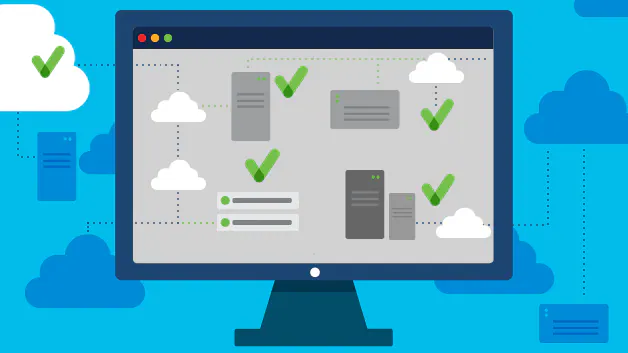The Uptime Chronicles: Keeping Your Digital Empire Alive 24/7
Dive into the world of uptime services, downtime monitors, and network vigilance. Learn how to keep your servers running smoothly and your digital presence thriving in an always-on world.
Posted by
 Sabyr Nurgaliyev
Sabyr Nurgaliyev
The Uptime Chronicles: Keeping Your Digital Empire Alive 24/7
Hey there, digital emperors and empresses! Ready to fortify your online kingdom against the dreaded downtime dragons? Buckle up, because we're about to embark on an epic quest through the realm of uptime services, downtime monitors, and all the magical tools that keep our virtual worlds spinning. It's time to become the master of your digital domain!
The Heartbeat of Your Digital Empire
Imagine you're ruling over a vast digital kingdom. Your subjects (aka users) come from far and wide to visit your online realm. But what happens when the drawbridge suddenly collapses, leaving everyone stranded outside? That's downtime for you, folks – the arch-nemesis of every digital ruler.
Why Uptime is Your Royal Decree
You might be thinking, "So what if my site takes a little nap now and then?" Oh, my sweet summer child! Let's break down why uptime should be your number one royal decree:
- The Gold in Your Coffers: Every second your site's down, you're basically tossing gold coins into a bottomless pit. Ka-ching... or rather, ka-plunk!
- The Loyalty of Your Subjects: Nothing makes your digital citizens revolt faster than a site that plays hide and seek. Reliability is the cornerstone of any thriving kingdom.
- The Favor of the Search Engine Gods: The almighty Google and its cohorts love reliability. High uptime could be your ticket to the coveted top of the search results mountain.
Uptime Services: Your Royal Guard
Now that we've established why uptime's the bee's knees, let's talk about the elite forces that keep your digital kingdom safe: uptime services. These valiant warriors are like having a tireless royal guard for your website – minus the fancy uniforms and sword-polishing duties.
What's an Uptime Service, Anyway?
Think of uptime services as the ever-vigilant sentinels of your digital realm. They're constantly patrolling, checking if your site's up, running, and not throwing a tantrum. But instead of shouting "All is well!" every hour, they send you alerts when something's amiss. Pretty nifty, huh?
The Royal Metrics of Uptime
When it comes to uptime services, there's more to it than just "Is the kingdom standing or not?" Here are some key metrics every digital ruler should keep an eye on:
- Response Time: How long does it take for your site to respond to a royal summons? If it's slower than a three-legged tortoise, you've got problems.
- Uptime Percentage: Aim for the golden 99.9% uptime. Anything less, and you might want to have a stern talk with your court wizard (aka hosting provider).
- Error Rates: Are your visitors getting more error messages than actual content? Time to put on your detective crown and investigate!
Downtime Monitors: Your Crystal Ball
Alright, let's shift gears and talk about downtime monitors. These magical tools are like having a crystal ball for your digital kingdom – always on the lookout for trouble brewing on the horizon.
The Anatomy of a Downtime Monitor
So, what makes a downtime monitor tick? Let's peek under the hood of this mystical machine:
- Constant Vigilance: These tools ping your site at regular intervals, sometimes as frequently as every minute. Talk about dedication! It's like having a guard who never sleeps (and never needs coffee breaks).
- Global Perspective: Good monitors check your site from various locations around the world. Because what's up in New York might be down in Tokyo. It's like having spies... er, ambassadors in every corner of the globe.
- Alert Systems: When trouble's brewing, they'll let you know via email, SMS, or maybe even carrier pigeon (okay, maybe not that last one). It's like having a town crier for the digital age.
Choosing Your Digital Oracle
With so many options out there, picking the right downtime monitor can feel like trying to find a needle in a haystack... while blindfolded... and the haystack is on fire. But fear not! Here are some factors to consider:
- Check Frequency: How often do you need your site monitored? Every minute? Every five minutes? Every time someone tweets about cats?
- Types of Checks: Do you need simple ping tests, or more complex transaction monitoring? It's like choosing between a guard dog and a full-blown security system with lasers and moats.
- Integration Capabilities: Does it play nice with your other tools and systems? You want a team player, not a lone wolf howling at the digital moon.
Remember, the best tool for you depends on your specific needs. It's like choosing a royal advisor – you need one that fits your ruling style!
Server Uptime: The Foundation of Your Digital Castle
Alright, let's dive into the nitty-gritty of server uptime. Your server is like the foundation of your digital castle – if it crumbles, the whole kingdom comes tumbling down.
The Secret Life of Servers
Server uptime is more than just a number on a dashboard. It's a complex dance of hardware, software, and network components all working in harmony. Here's a simplified breakdown:
- Hardware Health: This includes things like CPU temperature, disk space, and memory usage. Think of it as your server's physical fitness. You wouldn't want a wheezing, out-of-shape server defending your kingdom, would you?
- Software Stability: Are all the necessary services running? Is the operating system up to date? It's like making sure your server's brain is in tip-top shape, ready to outsmart any digital invaders.
- Network Connectivity: Is the server able to communicate with the outside world? Because what good is a fit body and sharp mind if you can't send messages to your digital subjects?
When Servers Go on Strike (Unplanned Downtime)
Even the best-laid plans of mice and sysadmins often go awry. Here are some common reasons your server might decide to stage a coup:
- DDoS Attacks: When your server gets bombarded with traffic from multiple sources, it can buckle under the pressure. It's like trying to defend your castle against an army of millions... armed with feathers. Annoying, right?
- Hardware Failures: Sometimes, physical components just give up the ghost. RIP, faithful hard drive. You served us well (pun intended).
- Software Bugs: A single line of bad code can bring down an entire system. It's like a digital butterfly effect, but instead of a hurricane, you get a server meltdown.
- Human Error: We're all human, after all. One misplaced semicolon can wreak havoc. Oops! It's like accidentally leaning on the big red "Destroy Kingdom" button.
Network Uptime Monitors: The Watchers on the Digital Wall
Now, let's zoom out a bit and talk about network uptime monitors. These tools are like the watchers on the wall in your favorite fantasy epic, keeping an eye on the vast network landscape beyond your server room.
Why Network Monitoring Matters
You might be thinking, "I've got my server uptime sorted. Why do I need to worry about the network?" Well, my friend, here's the deal:
- Big Picture View: Network monitors give you a bird's-eye view of your entire digital infrastructure. It's like having a map of all the roads in your kingdom, not just your castle courtyard.
- Proactive Problem Solving: Identify and fix issues before they snowball into major outages. It's like fixing a small crack in your castle wall before it becomes a gaping hole.
- Performance Optimization: It's not just about being up – it's about being fast and efficient too. Because who wants to live in a kingdom where the royal messenger takes three days to deliver a letter to the next room?
Key Features of Network Uptime Monitors
Not all network monitors are created equal. Here are some features to look out for:
- Real-Time Alerts: Get notified the moment something goes wonky. It's like having a personal assistant for your network who never sleeps (and never complains about it).
- Bandwidth Analysis: Keep an eye on those data hogs. Who's streaming 4K cat videos on the royal network?
- Visual Network Mapping: Because sometimes, a picture really is worth a thousand words. Or in this case, a thousand data packets. It's like having a magical map that shows you where all your digital citizens are and what they're up to.
The Psychology of Uptime: Why It Matters to Your Digital Subjects
Let's take a step back from the technical stuff and talk about the human side of uptime. After all, at the end of the day, it's all about keeping your digital subjects (aka users) happy, right?
The Trust Factor
Imagine you're trying to buy something from the royal marketplace, but the stalls keep disappearing into thin air. How likely are you to whip out your gold coins and make a purchase? Not very, I'd wager. Uptime is all about building trust with your users. It's like being the reliable ruler who always keeps the kingdom's gates open, come rain or shine.
The Ripple Effect of Downtime
When your site goes down, it's not just a temporary inconvenience. It can have long-lasting effects on your digital kingdom:
- Lost Opportunities: Every moment of downtime is a potential customer lost. It's like closing your kingdom's borders during a major trade fair.
- Negative Word-of-Mouth: People love to share bad experiences. One downtime incident can turn into a PR nightmare faster than you can say "The king is dead, long live the king!"
- Increased Support Costs: When your site's down, guess who's carrier pigeon is working overtime? Your poor support team!
Uptime in the Age of Mobile: New Challenges, New Solutions
With more and more people accessing the web on their smartphones, the game of uptime has changed. It's like suddenly realizing half your kingdom's population has grown wings and can fly. Let's explore how mobile has shaken things up!
The Mobile Uptime Conundrum
Mobile users are a fickle bunch. They expect sites to load faster than you can say "4G LTE." Here's what you need to consider:
- Network Variability: Mobile networks can be unpredictable. Your site needs to be robust enough to handle varying connection speeds. It's like designing a carriage that can handle both smooth royal roads and bumpy country lanes.
- Device Diversity: From the latest iPhone to a budget Android device, your site needs to stay up and running on all of them. It's a digital version of "one size fits all" – except it actually has to fit all.
- Battery Considerations: Heavy sites that drain battery life quickly can be perceived as "down" by mobile users. Don't be an energy vampire! It's like making sure your kingdom doesn't suck the life force out of its visitors.
Mobile-Friendly Monitoring
Traditional uptime monitoring tools might not cut it for mobile. Here are some mobile-specific monitoring considerations:
- Real User Monitoring (RUM): This tracks the actual experience of your mobile users in real-time. It's like having spies... er, loyal subjects reporting back on their experiences in different parts of your kingdom.
- Synthetic Monitoring: Simulates mobile user behavior to catch issues before they affect real users. Think of it as sending out decoy subjects to test the waters before your real citizens dive in.
- App Performance Monitoring: If you have a mobile app, you'll need specialized tools to monitor its uptime and performance. Because in the mobile world, your app is your mini-kingdom within the larger digital realm.
The Future of Uptime: Emerging Trends and Technologies
Alright, time to put on our wizard hats and gaze into the crystal ball. What does the future hold for uptime monitoring and management in our ever-evolving digital kingdoms?
AI and Machine Learning in Uptime Management
Artificial Intelligence isn't just for chess games and virtual assistants. It's making waves in the world of uptime too:
- Predictive Maintenance: AI can analyze patterns and predict when a server is likely to fail, allowing for preemptive action. It's like having a court prophet who can actually see the future (and isn't just making stuff up).
- Automated Problem Resolution: Imagine a system that not only detects issues but fixes them automatically. We're getting there! It's like having self-repairing castle walls.
- Smarter Alerting: AI can help reduce alert fatigue by only notifying you of truly critical issues. No more crying wolf in the server room!
The Rise of Edge Computing
Edge computing is changing the game when it comes to uptime and performance:
- Reduced Latency: By processing data closer to the source, edge computing can significantly improve response times. It's like having mini-castles all over your kingdom instead of one central fortress.
- Improved Reliability: With data distributed across multiple edge locations, the risk of a single point of failure is reduced. It's the digital equivalent of not putting all your eggs in one basket – or all your treasure in one vault.
- Scalability: Edge computing makes it easier to handle sudden spikes in traffic without compromising uptime. It's like having a kingdom that can magically expand to accommodate more subjects during festival season.
DIY Uptime: Tips and Tricks for the Hands-On Digital Ruler
Not everyone has the budget for fancy monitoring tools or high-end hosting. If you're more of a DIY monarch, here are some tips to keep your digital kingdom up and running:
The Peasant's Guide to Monitoring
You don't need a royal treasury to keep an eye on your site. Here are some free or low-cost options:
- Pingdom's Free Plan: While not as feature-rich as paid options, it's a solid starting point for basic monitoring. It's like having a loyal guard dog that might not know fancy tricks but will definitely bark when there's trouble.
- Google Analytics Real-Time: While not a dedicated monitoring tool, it can give you a heads-up if traffic suddenly drops to zero. It's like noticing that the usual hustle and bustle of your marketplace has suddenly gone quiet.
- IFTTT + Webhooks: Create your own monitoring system using IFTTT (If This Then That) and webhook services. It's like building a Rube Goldberg machine for uptime monitoring – complicated, but oddly satisfying when it works.
Optimizing Your Digital Kingdom for Maximum Uptime
Sometimes, the best defense is a good offense. Here are some ways to make your site more resilient:
- Caching: Implement a good caching strategy to reduce server load. It's like having a really good memory so you don't have to look up the same information over and over again.
- Content Delivery Networks (CDNs): Distribute your content across multiple servers worldwide for improved reliability and performance. It's like having copies of your royal library in every major city of your kingdom.
- Regular Backups: Always have a recent backup ready in case things go south. It's your digital insurance policy – because even the best-run kingdoms sometimes face disasters.
The Legal Side of Uptime: SLAs and Guarantees
Let's put on our royal judge wigs for a moment (don't worry, we won't sentence anyone to the stocks). Understanding the legal aspects of uptime can save you a lot of headaches down the road.
Decoding Service Level Agreements (SLAs)
An SLA is like a royal decree from your hosting provider or monitoring service. But like any decree, it's only as good as the fine print. Here's what to look for:
- Uptime Percentage: 99.9% sounds great, but what does it mean in real terms? (Hint: It's about 8 hours of downtime per year) It's like promising your subjects you'll only be unavailable for 8 hours a year – sounds good until you realize that could be 8 consecutive hours during the busiest market day.
- Compensation: If they fail to meet the SLA, what do you get? Credits? Refunds? A heartfelt apology written in calligraphy?
- Exclusions: What situations are not covered by the SLA? Scheduled maintenance? Acts of God? Dragon attacks?
The Truth About Uptime Guarantees
"100% uptime guarantee!" Sounds amazing, right? But let's be real – nothing is 100% in this world (except maybe my love for a good medieval feast). Here's the deal:
- The 9s Game: 99.9% vs. 99.99% vs. 99.999% – each additional 9 makes a big difference. It's like the difference between being late to the royal ball by a minute or an hour.
- Measurement Period: Is the guarantee based on monthly uptime? Yearly? The difference matters. A year with 99.9% uptime sounds great until you realize all that downtime happened during your busiest month.
- Proof of Downtime: How do you prove your site was down? Make sure you have your own monitoring in place. Trust, but verify – it's not just for international diplomacy!
Uptime Across Borders: Global Considerations
In our interconnected world, your digital kingdom might be accessed from Timbuktu to Timbukthree. Let's talk about keeping your site up and running on a global scale.
The Challenge of Global Uptime
Maintaining uptime across different countries and continents brings its own set of challenges:
- Network Latency: The further the data has to travel, the longer it takes. This can affect perceived uptime. It's like trying to send a message by horseback across continents – sometimes it arrives a bit late and dusty.
- Legal Compliance: Different countries have different laws about data storage and privacy. Make sure you're compliant! It's a digital version of "When in Rome, do as the Romans do" – except you need to do it in every country simultaneously.
- Cultural Differences: What's considered "up" in one country might not cut it in another. Expectations vary! It's like realizing that what passes for a feast in one kingdom is considered a light snack in another.
Strategies for Global Uptime Success
Here are some strategies to keep your site running smoothly worldwide:
- Geo-Distributed Hosting: Use multiple servers in different geographic locations. It's like having embassies for your website around the world.
- Local Caching: Implement caching servers in key markets to reduce latency. Think of it as setting up local branches of your royal library in major cities.
- 24/7 Support: If you're going global, your support needs to be global too. The sun never sets on your digital empire!
The Human Element: Building an Uptime-Focused Team
All the fancy tools and technologies in the world won't help if your team isn't on board. Let's talk about the human side of uptime management.
Cultivating an Uptime Culture
Creating a culture that prioritizes uptime is crucial. Here's how:
- Clear Communication: Make sure everyone understands the importance of uptime and their role in maintaining it. It's like making sure every knight knows their role in defending the castle.
- Incentivize Uptime: Consider tying bonuses or other rewards to uptime metrics. Nothing motivates like a little extra gold in the coffers, right?
- Post-Mortem Analysis: When downtime does occur, use it as a learning opportunity rather than a blame game. It's like turning a lost battle into a valuable lesson for future victories.
Training and Skill Development
Keeping your team's skills sharp is key to maintaining high uptime:
- Regular Training: Technology changes fast. Make sure your team stays up-to-date. It's like sending your knights to regular training exercises.
- Cross-Training: The more your team members know about different aspects of your infrastructure, the better they can respond to issues. Jack of all trades, master of uptime!
- Simulated Downtime: Run "fire drills" to test your team's response to various downtime scenarios. Practice makes perfect, even in the digital realm.
FAQs: Your Burning Uptime Questions Answered
Still got questions? Fear not, loyal subjects! Here are some frequently asked questions about uptime services and monitoring:
Q1: What's a good uptime percentage to aim for?
A: While 100% uptime is the dream, it's not realistic. Aim for 99.9% or higher, which translates to less than 9 hours of downtime per year. Remember, even 0.1% downtime can mean lost opportunities!
Q2: How often should I check my site's uptime?
A: Ideally, you want real-time monitoring. At a minimum, check every 5 minutes for critical sites. It's like taking your website's pulse – the more often, the better.
Q3: Can I improve my site's uptime without spending a fortune?
A: Absolutely! Start with optimizing your site, using caching effectively, and implementing basic monitoring tools. Small steps can make a big difference. It's like fortifying your castle with what you have before investing in a moat and drawbridge.
Q4: What's the difference between uptime and availability?
A: Uptime refers to whether a system is operational, while availability includes factors like performance and user experience. A slow site might be "up" but not truly "available" from a user's perspective. It's like the difference between your castle gates being open and actually being able to welcome visitors efficiently.
Q5: How do I choose between different uptime monitoring tools?
A: Consider factors like your budget, the size of your site, the features you need (e.g., SMS alerts, integrations), and the tool's reputation for accuracy and reliability. It's like choosing the right sentinel for your digital watchtower.
Q6: What should I do when my site goes down?
A: First, don't panic! Have a documented response plan in place. Identify the cause, communicate with your users if the downtime is significant, and work on both short-term fixes and long-term prevention. It's like having a battle plan ready before the enemy even reaches your gates.
Conclusion: Ruling Your Digital Kingdom with an Iron Uptime
Whew! We've covered a lot of ground, from the basics of uptime services to advanced monitoring strategies and global considerations. If there's one thing to take away, it's this: uptime isn't just a technical metric – it's the very lifeblood of your digital kingdom.
Remember, achieving perfect uptime is like seeking the Holy Grail – a noble quest, but one that requires constant vigilance, ongoing learning, and a willingness to adapt to new challenges. But with the right tools, strategies, and mindset, you can keep your digital realm thriving, your subjects happy, and your online presence growing.
So go forth, implement what you've learned, and may your servers never sleep and your sites always shine! And hey, if you ever need a refresher, you know where to find us. Stay up, stay awesome, and long live your digital empire!
Learn more about high availability concepts on IBM's website
Related Articles

Dive into the world of uptime services, downtime monitors, and network vigilance. Learn how to keep your digital presence thriving 24/7 and why every second counts in the online realm.
 Sabyr NurgaliyevSep 7, 2024
Sabyr NurgaliyevSep 7, 2024
Dive into the world of uptime services and downtime monitors. Learn how to keep your servers running smoothly, maximize network uptime, and choose the right tools for your business.
 Sabyr NurgaliyevSep 6, 2024
Sabyr NurgaliyevSep 6, 2024
Discover the secrets of server uptime monitoring and learn how to keep your digital services running smoothly 24/7. Explore cutting-edge tools, best practices, and expert strategies for minimizing downtime and maximizing performance.
 Sabyr NurgaliyevAug 29, 2024
Sabyr NurgaliyevAug 29, 2024
Discover how website monitoring apps, network uptime monitors, and uptime services ensure your online presence remains uninterrupted. Learn about the importance of downtime monitoring and server uptime.
 Sabyr NurgaliyevAug 21, 2024
Sabyr NurgaliyevAug 21, 2024
Discover the top tools and strategies to keep your network and servers running smoothly, and learn how to minimize downtime.
 Sabyr NurgaliyevSep 4, 2024
Sabyr NurgaliyevSep 4, 2024
A deep dive into the world of network uptime monitors, downtime monitors, and server uptime. Discover how to keep your website online and your business thriving.
 Sabyr NurgaliyevAug 27, 2024
Sabyr NurgaliyevAug 27, 2024